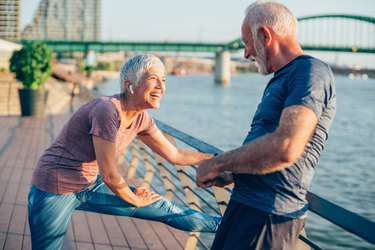
While cardio is important for overall health and longevity, strength training helps people — especially older adults — improve their strength and balance.
This ultimately helps prevent future falls and injuries, according to the Centers for Disease Control and Prevention. And that's important because more than 95 percent of hip fractures in older adults occur as a fall-related injury, after which many people can no longer live alone.
Video of the Day
Luckily, Maillard Howell, CPT, a CrossFit Level 2 coach, co-owner of Dean CrossFit and founder of wellness program The Beta Way, has created a leg-toning workout older adults can follow to improve their strength and balance, emphasizing knee strength to help stabilize the leg.
The Warmup
1. Banded Lateral Walk
- Begin with a resistance band around your feet, ankles or shins (not your knees!).
- With your hands clasped at your chest, bend your knees slightly and take a wide step to the right.
- Avoid touching your feet together between steps as you continue these side steps.
- Step to the right 10 times, then step to the left 10 times.
Tip
Howell recommends performing this resistance band exercise at least three times a week to stimulate your muscles.
2. Wall Sit
- Lean you back against a wall with your arms straight out in front of you.
- Keeping your knees behind your toes and your back straight, slowly lower your back down the wall.
- Lower until your legs form a 90-degree angle.
- Hold this position for 10 seconds before you reverse the motion back to standing. Rest for 30 seconds.
- Repeat for 5 to 7 minutes total as a warmup.
The Workout
1. Step Up
- Stand in front of a fairly low bench or step about 6 inches tall.
- Step up onto the bench or step with your right foot.
- Press through the heel of your right foot and push your body up until your right leg is straight.
- Bring your left foot up onto the bench so it's even with your right foot.
- Control your body as you lower your left foot back to the floor and return to the starting position.
- Do 4 rounds of 12 reps on each side.
Tip
Once you become comfortable with step-ups, you can increase the height of the bench as you become stronger. For older athletes, avoid stepping higher than knee height, Howell says.
For an added challenge, perform a front-loaded step-up by holding a 10-pound plate or a light medicine ball at your chest as you do the exercise. As you grow stronger, increase the weight while maintaining good form.
2. Box Squat
- Stand with your feet shoulder-width apart in front of a bench or chair, facing away from it.
- Hinge your hips back and slowly lower your body toward the bench, keeping your knees behind your toes.
- Keep your shoulders back and your chest up.
- Tap the bench with your glutes before you return to standing.
- Do 4 rounds of 10 reps.
Tip
According to Howell, box squats are excellent for building your quad muscles. Box squats maximize the strength benefits of a squat while minimizing risk by shortening the range of motion of a full squat.
3. Forward Step Down
- Stand on top of a fairly low bench or step about 6 inches tall, hands on your hips.
- Step down onto the floor with your left foot.
- Push through your right foot to reverse the motion and return your left foot to the bench or step.
- Do 4 rounds of 12 reps on each side.
4. Deadlift
- Holding a light dumbbell in each hand, palms facing in, stand with your feet hip-width distance apart.
- Keeping your back flat, hinge at your hips and lower the weight toward the ground.
- Bend your knees slightly and hover the weight a few inches off the ground. You should feel a stretch in your hamstrings.
- Reverse the motion, pushing your hips forward and straightening your body.
- Return to standing.
- Do 4 rounds of 10 reps.